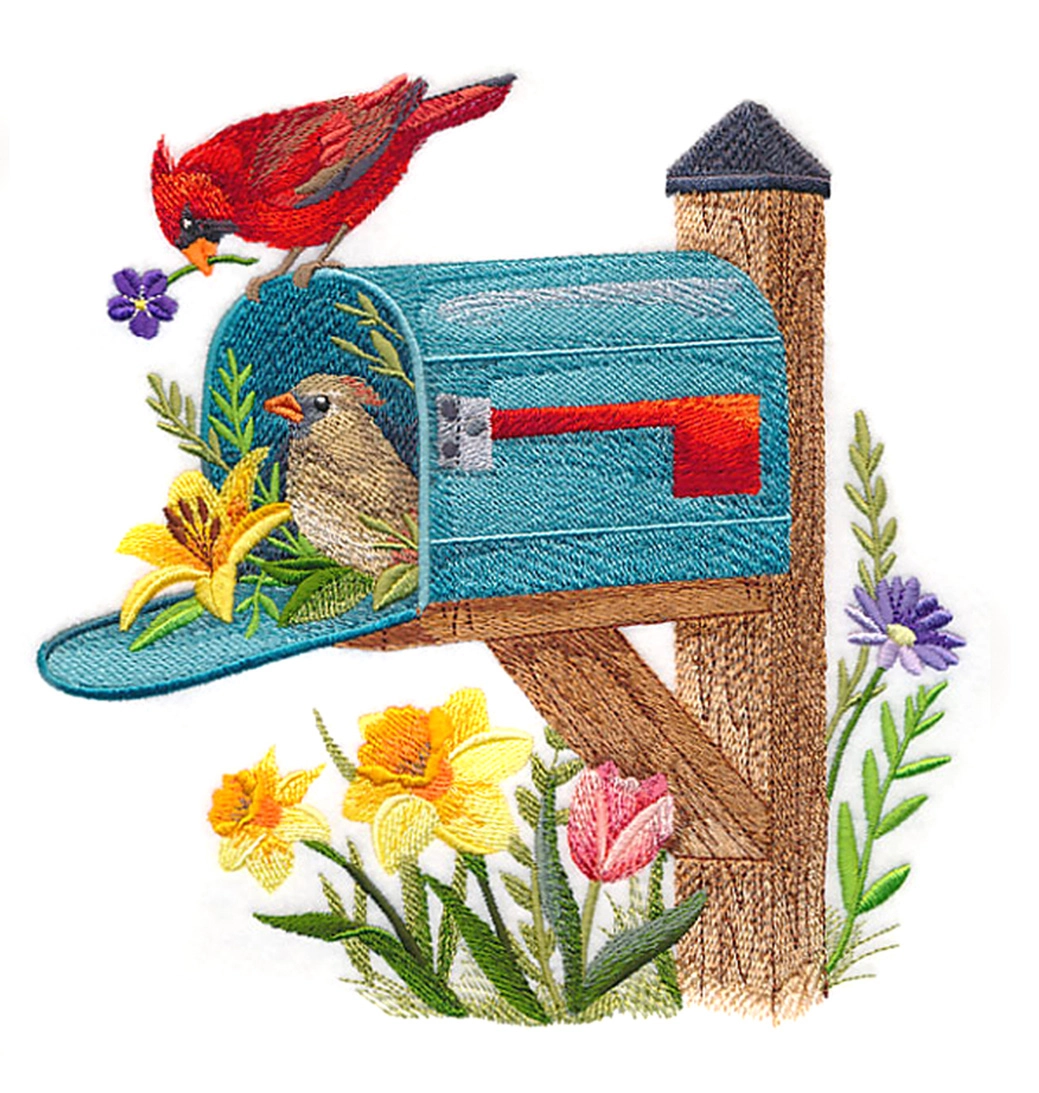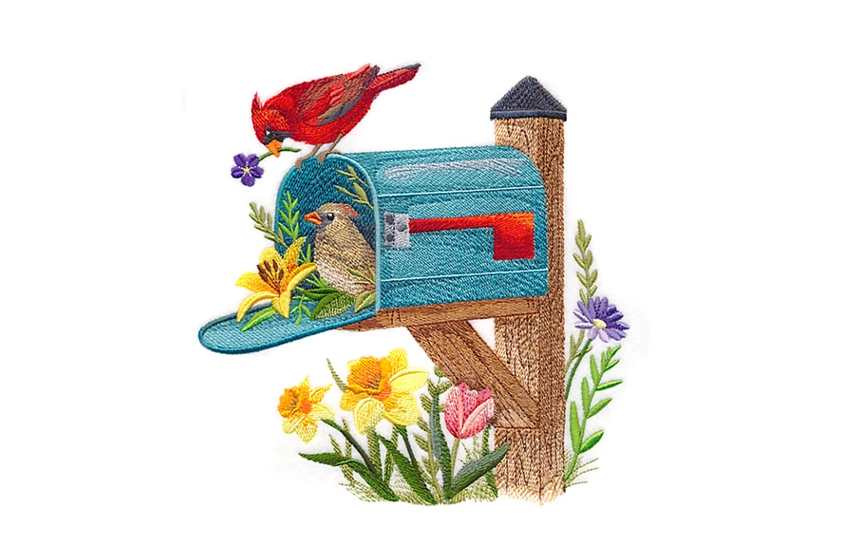Accessorize in charming style! This adorable coin purse stitches in-the-hoop, with a zipper across the back to secure your treasures. Delicate embroidered decoration adds a perfect touch of fashionable flair. We'll show you step-by-step how to stitch your own!
Supplies
- 1/2 yard quilter's cotton
- Small pieces of quilter's cotton (for applique)
- All-purpose zipper (11" + zipper for small size, or 13" + zipper for large size)
- Elastic, cord, or ribbon (for strap)
- Scissors
- Masking tape
- Temporary spray adhesive
- Tear-away stabilizer
- Seam ripper
Finished size: About 5"x5 1/2" for large size; about 3"x4" for small size
Special Notes:
As the last color stop of file "b" sews the "a" and "b" pieces together, make sure to completely embroider file "a" before embroidering file "b".
Designs Used
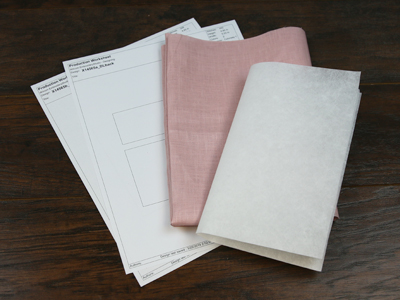
When you download the in-the-hoop zipper-back coin purse design, you will find multiple files. Some are the embroidery files, and the others are dieline files marked with the letters "DL". Dielines are used to cut the fabric to the correct shape and size. Open and print each dieline file using an embroidery software. If you do not have an embroidery software, take a look at our helpful video on using dielines.
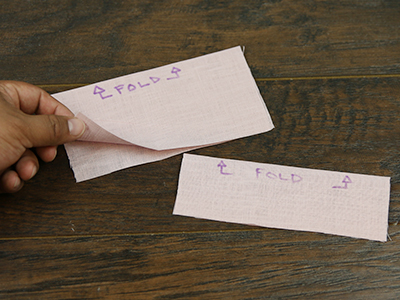
To begin preparing the fabric pieces, cut two rectangles out of the main fabric that are twice as wide as the back (file "a") top and bottom pieces.
Press the folded edge and spray the wrong side of the fabric with temporary adhesive to hold the folded fabric together. Adhering the two folded sides together will help prevent shifting and make the pieces easier to cut.
Note that for the larger heart coin purse, these pieces are rectangles, as shown here. The smaller version stitches diagonally, so those pieces will be squares folded diagonally to make triangles (see below).
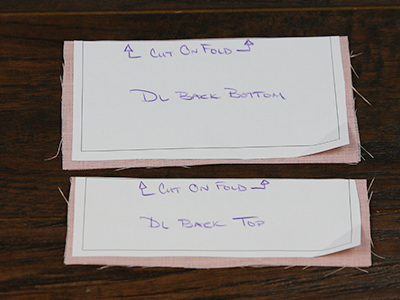
Next, spray the back of the back paper dieline pieces (file "a") with temporary adhesive and smooth them onto the right side of the fabric, matching one edge up with the folded side. It can be helpful to label to pieces so that they don't get mixed up.
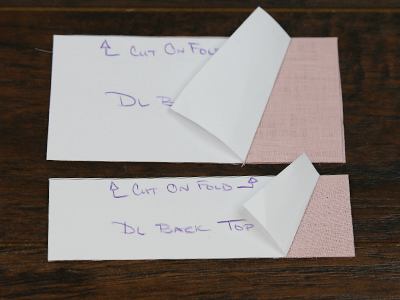
Cut the two back pieces out on the fold and fold up one corner of the paper dieline.
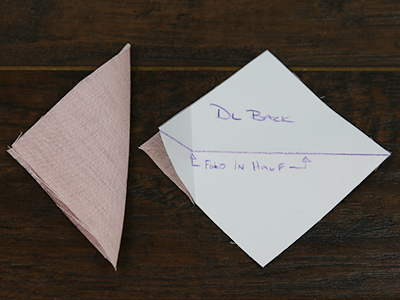
For the smaller design, use the provided dielines to cut two squares, then fold them diagonally to create a triangle out of each.
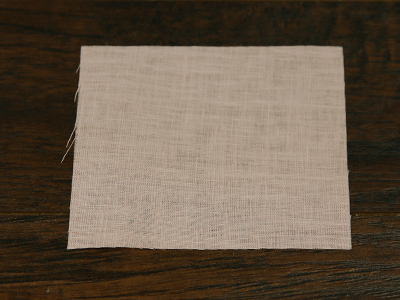
For the front pieces (file "b"), simply spray the paper dieline with temporary adhesive and smooth it onto the right side of the flat, unfolded fabric. Then cut out the shapes and remove the paper.
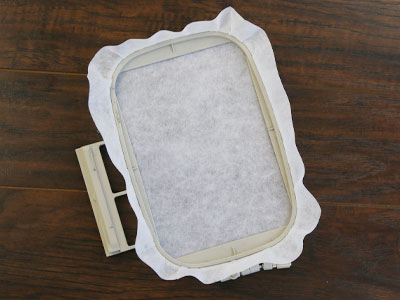
Now that the fabric pieces are ready, hoop a piece of tear-away stabilizer tightly. Madeira E-Zee Tear 1.5 oz. or Floriani Tearaway Medium are good choices. Those brands are more fibrous, less paper-like, and will tear more cleanly.
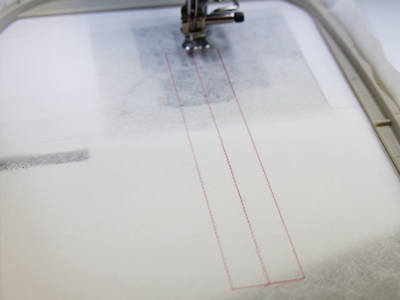
Load the back embroidery file (file "a") onto the machine, and begin to embroider the design. The first thing to sew will be the "zipper dieline". This marks the place where the zipper will be placed on the stabilizer.
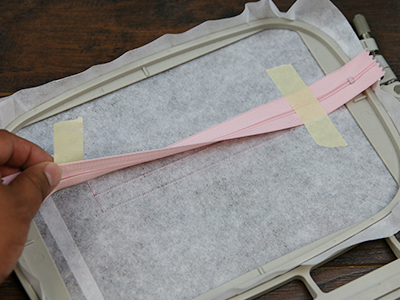
The zipper dieline sews a box with a centerline through the middle. To place the zipper correctly, close the zipper and match up the center of the zipper (the teeth that zip and unzip) with the sewn centerline. Make sure the wrong side of the zipper is against the stabilizer and tape it in place. The zipper should hang over on both sides and will be trimmed away later.
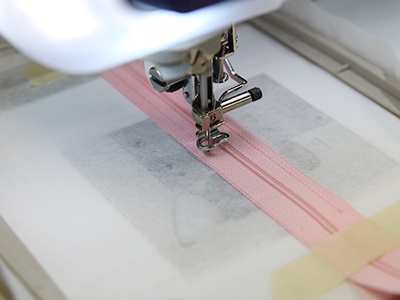
Once the zipper is taped down, place the hoop back on the machine and embroider the "zipper tackdown" step. This will adhere the zipper to the stabilizer and hold it in place for the remainder of the design. Don't worry if it sews over the tape. It can be easily torn away from around the stitches.
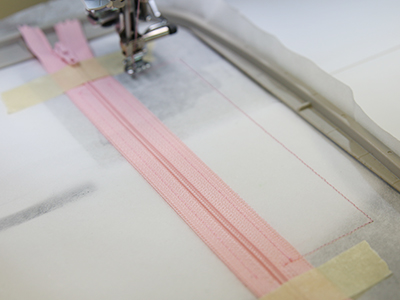
Embroider the "top front piece dieline" step. This will sew an outline where the top front fabric piece will go.
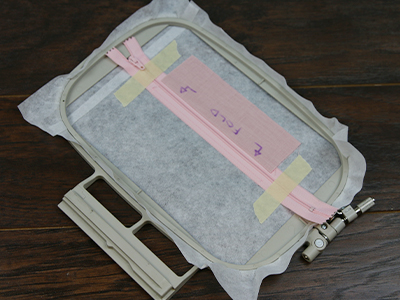
Spray the back side of the folded top front fabric piece with temporary adhesive (the side w/o paper). With the folded edge alongside the zipper, smooth the fabric piece inside the sewn dieline shape.
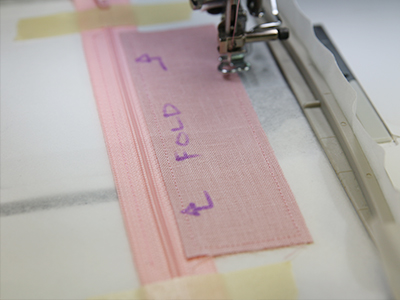
Continue to embroider the "top front piece tackdown" step.
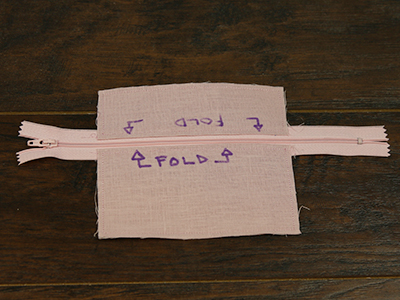
Repeat the previous steps to embroider the "bottom front piece dieline". Place the fabric piece and embroider the tackdown. Again, make sure that the folded edge is against the zipper. Once the design has finished embroidering, trim away the excess stabilizer from around the back piece. Do not cut the zipper.
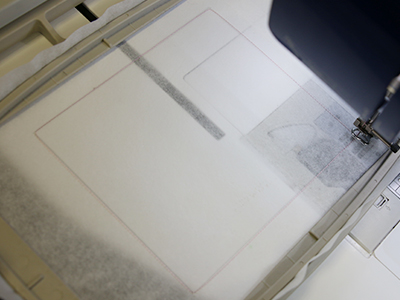
Once the back piece (file "a") is completed, hoop another piece of tear-away stabilizer and load the front (file "a") onto the machine. The first thing to embroider will be the dieline for the main fabric piece.
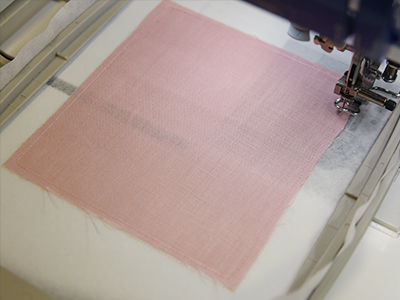
Place the fabric piece in the sewn dieline, and embroider the tackdown step.
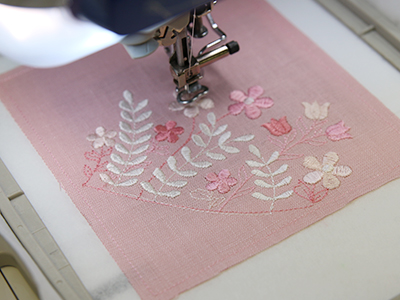
Next, the inner details of the design will sew. Follow the color change sheet, and stop before sewing the "finishing seam".
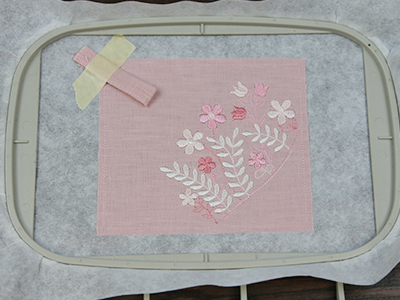
Before sewing the "finishing seam", stop the machine and remove the hoop without unhooping the design.
To add a wrist strap, cut a piece of cord 8"-12" long. Fold it in half and place the looped end on the inside of the pouch (so the raw edges hang over the edge). Tape it in place over the embroidered details, and make sure the loop will not get caught in the finishing seam.
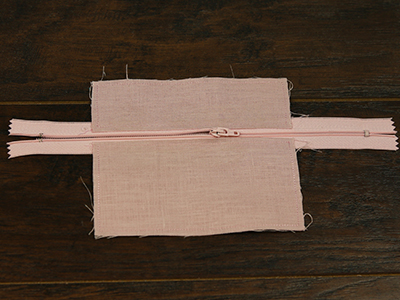
On the back piece (file "a"), it is very important to move the slider of the zipper (also called the pull tab) to the center of the design. This will leave the zipper about half open and will allow the slider to be a part of the zipper pouch, so it can be opened and closed. If you do not move the slider, the pouch will be permanently stuck closed, so do not forget!
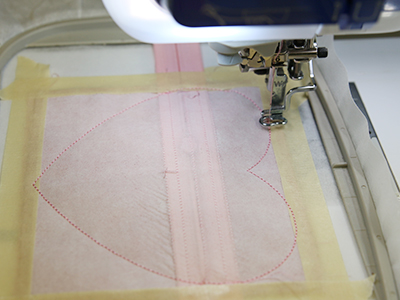
Next, lay the back piece (file "a") with the half open zipper on top of the hooped front piece (file "b") with the right sides together. Match up the outer edges, and tape the back piece in place around all four sides of the design.
Place the hoop back onto the machine, and embroider the final "finishing seam step. This will bind all the layers together, and create the final shape of the purse.
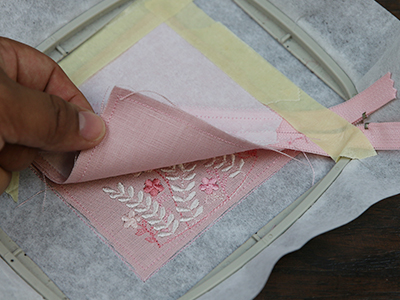
For the smaller version, the zipper will run diagonally across the embroidered square. Make sure your zipper crosses the area where the heart will stitch from side to side, not top to bottom.
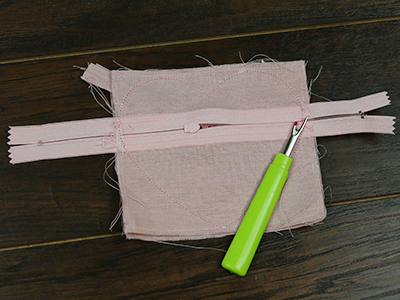
Once the design has finished sewing, tear away the excess stabilizer from around the design. Carefully remove the stabilizer from the back of the front side of the design to give it more flexibility.
Repeat the previous step to remove the stabilizer from the back side of the back piece as well to uncover the zipper opening and make the bag more flexible.
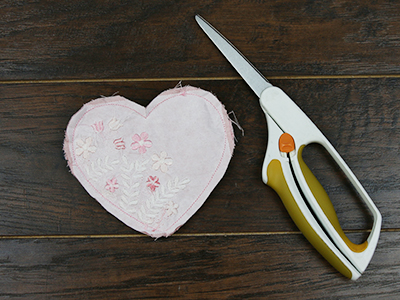
After all the tear-away stabilizer has been removed, trim away the excess fabric by cutting around the finishing seam. Only leave about a 1/4" of seam allowance around the shape for best results. Also cut both sides of the zipper off about 1/4" away from the finishing seam.
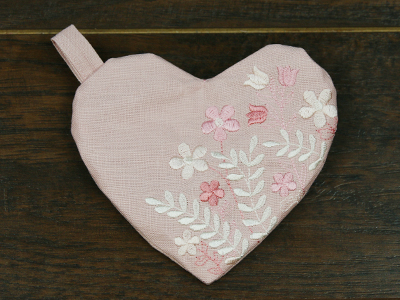
Finally, turn the pouch right side out through the open zipper. Remove any tape and press the edge.

